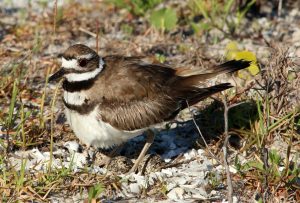We approached the nest slowly, watching where we stepped on the white sand of the Emerald Coast dunes. There had been three eggs the day before, but only one chick and egg remained. The team of wildlife specialists explained that the other baby was probably already running around, so we had to be extra careful!
My guides work for Eglin Air Force Base, the entity that owns barrier island property along Okaloosa Island. Though the base does use the area for mission-related activities, it is mostly undeveloped, providing important habitat for shorebirds and other dune-dependent species.
I love birding, and yet I had never before seen a baby shorebird! The Eglin part of the island is closed off to normal visitors, so tagging along with Eglin staff presented my only opportunity to check out documented nests.
As we approached, the two Snowy Plover parents went into broken wing displays. If we had been predators, their distracting actions would (hopefully) have pulled us away from the vulnerable nests and chicks.
The nest itself was unbelievably camouflaged, really a small cup in the sand itself. A tiny chick lay resting, so newly hatched that it was still wet! Next to it sat an as-of-yet unopened egg, but we could all hear the insistent tapping sounds coming from the inside, letting the parents know a new chick was on its way.
We were in and out in only a few minutes to avoid disturbing the parents. The Eglin staff used to have a banding program, but now only measure hatchling success. Still, it is important to know how many parents can successfully make it to this stage. Farther down the road, another nest with three speckled eggs lay waiting to hatch, representing three new lives to add to the threatened Snowy Plover population.
In addition to the nesting plovers, we found a Killdeer nest, and a circling Common Nighthawk indicated it had eggs or chicks nearby as well. Sea turtles use beaches to dig their giant nests, and wildlife biologists monitor them from May through October. The data collected from the latter was used in an MP by a CEM who graduated in 2016.
I like to emphasize conservation partnerships, and Eglin’s wildlife management is just one example of many positive military-nature benefits they provide to the local community. In addition to plover projects, their staff monitor Red-cockaded Woodpeckers, Gopher Tortoises, Okaloosa Darters, Burrowing Owls, and more!




